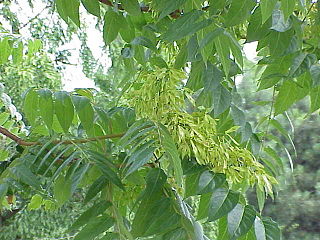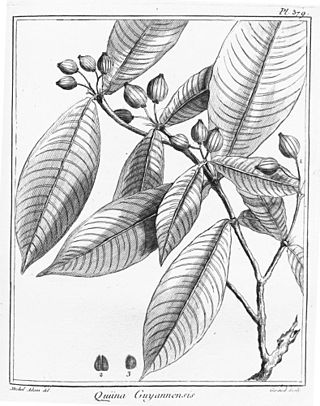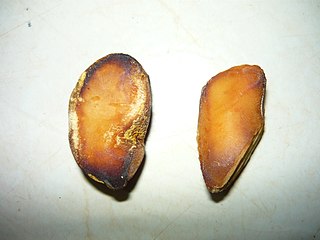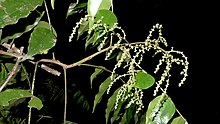
Quassia is a plant genus in the family Simaroubaceae. Its size is disputed; some botanists treat it as consisting of only one species, Quassia amara from tropical South America, while others treat it in a wide circumscription as a pantropical genus containing up to 40 species of trees and shrubs.

Xylosma is a genus of flowering plants in the family Salicaceae. It contains around 100 species of evergreen shrubs and trees commonly known as brushhollies, xylosmas, or, more ambiguously, "logwoods". The generic name is derived from the Greek words ξύλον (xylon), meaning "wood, tree", and ὀσμή (osmé), meaning "smell", referring to the fragrant wood of some of the species. The Takhtajan system places it in the family Flacourtiaceae, which is considered defunct by the Angiosperm Phylogeny Group.

Zanthoxylum is a genus of about 250 species of deciduous and evergreen trees, shrubs and climbers in the family Rutaceae that are native to warm temperate and subtropical areas worldwide. It is the type genus of the tribe Zanthoxyleae in the subfamily Rutoideae. Several of the species have yellow heartwood, to which their generic name alludes. Several species are cultivated for their use as spices, notably including Sichuan pepper.

The Simaroubaceae are a small, mostly tropical, family in the order Sapindales. In recent decades, it has been subject to much taxonomic debate, with several small families being split off. A molecular phylogeny of the family was published in 2007, greatly clarifying relationships within the family. Together with chemical characteristics such as the occurrence of petroselinic acid in Picrasma, in contrast to other members of the family such as Ailanthus, this indicates the existence of a subgroup in the family with Picrasma, Holacantha, and Castela.

Protium is a genus of more than 140 species of flowering plants in the family Burseraceae. It is native to the Neotropics from northern Mexico to Paraguay and southern Brazil, and to Madagascar, the Indian subcontinent, Indochina, southern China, the Philippines, Java, and New Guinea. The genus had been included in Bursera, but is distinct.

Machaerium is a genus of flowering plants in the family Fabaceae, and was recently assigned to the informal monophyletic Dalbergia clade of the Dalbergieae. It contains the following species:

Amyris is a genus of flowering plants in the citrus family, Rutaceae. The generic name is derived from the Greek word αμυρων, which means "intensely scented" and refers to the strong odor of the resin. Members of the genus are commonly known as torchwoods because of their highly flammable wood.
Henriettea is a genus of flowering plants in the family Melastomataceae, with some 399 species accepted. It is distributed in the Americas. Some species in the genus are known commonly as camasey., though the common name camasey may also refer to plants of genus Miconia.
Pierreodendron is a genus of plants in the family Simaroubaceae.
Pseudolmedia is a flowering plant genus in the mulberry family (Moraceae). Species are found in southern Mexico, the Caribbean, and Meso- and South America. They are known in Latin America as lechechiva and used for timber, construction wood, and sometimes in folk medicine.

Quiina is a genus of plant in family Ochnaceae. It contains the following species :

Schnella is a genus of flowering plants in the legume family, Fabaceae. It belongs to the subfamily Cercidoideae. All of its species are neotropical lianas.

Hippocratea is a genus of flowering plants in the family Celastraceae, usually lianas, native to tropical and subtropical North America, South America and Africa.

Simaba is a genus of flowering plants belonging to the family Simaroubaceae.

Zanthoxyloideae is a subfamily of the family Rutaceae.
Homalolepis is a genus of flowering plants belonging to the family Simaroubaceae.

Samadera is a genus of trees belonging to the family Simaroubaceae, in the order Sapindales. The genus is native to eastern Africa (Tanzania), across to parts of tropical Asia and parts of eastern Australia.












